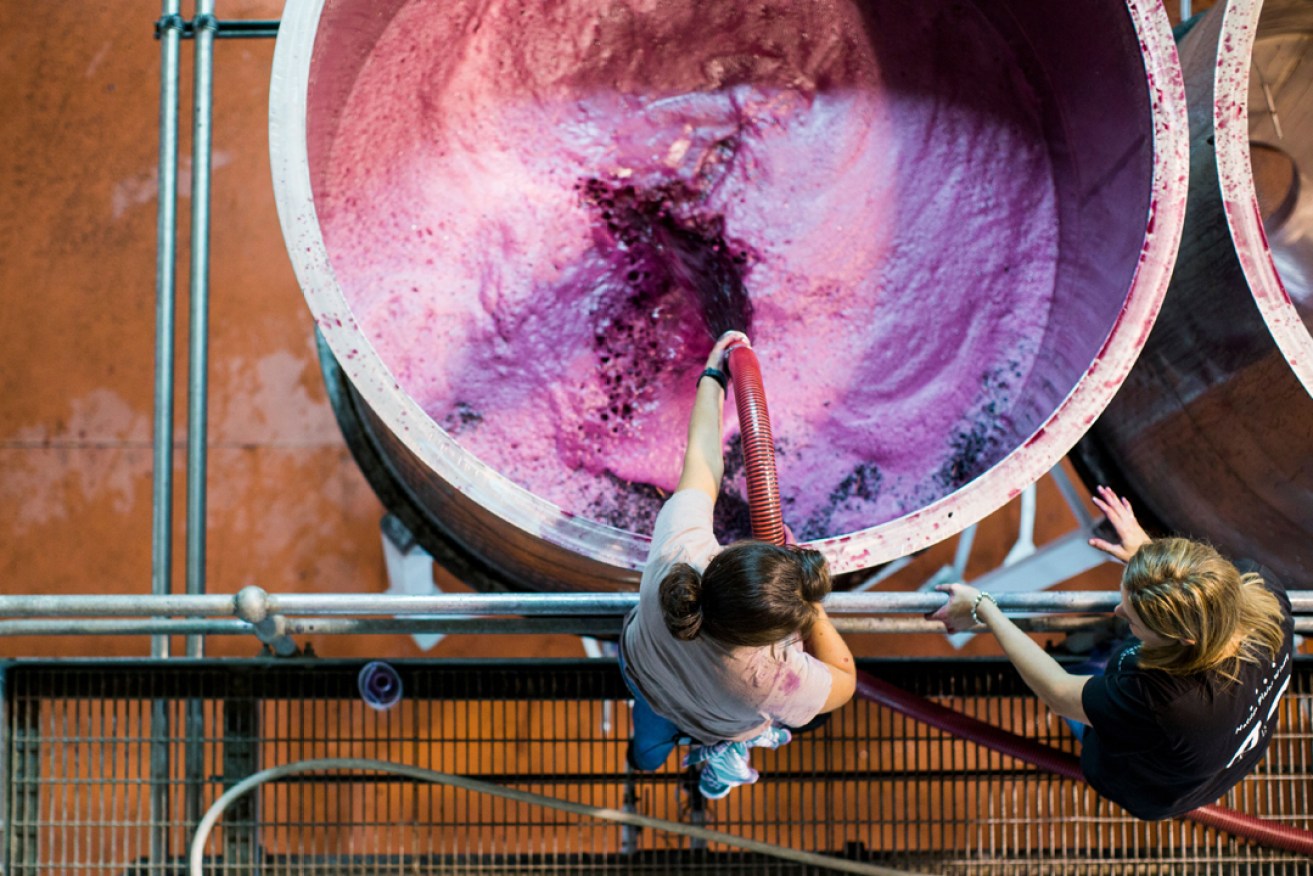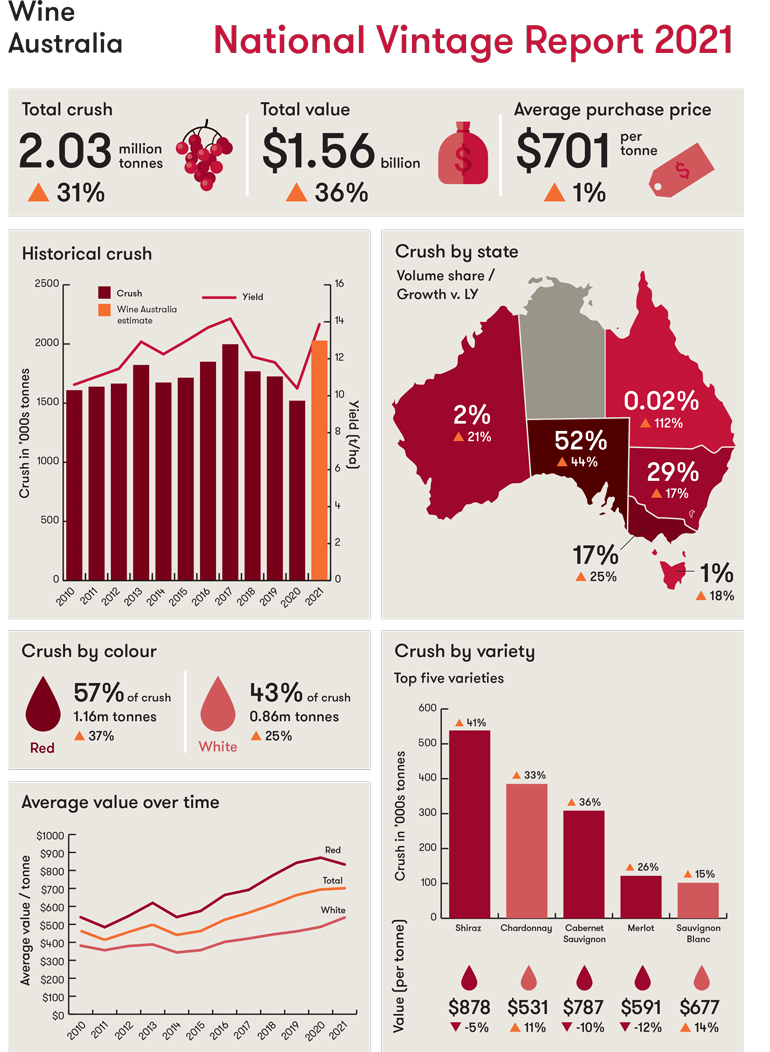Bumper harvest threatens to knock wine industry further off balance
A record grape harvest this year on the back of a vanishing Chinese export market is expected to put a kind of pressure on the state’s wine industry not seen in more than a decade – but experts say it’s too early to predict if Australia is headed for a wine glut.


In a normal year, the high-quality bumper harvest of 2.03 million tonnes in Australia would be celebrated as a boon for the industry, especially as it followed two drought and bushfire affected vintages that depleted Australia’s wine inventories to their lowest levels since 2011.
However, this year’s record crop will replenish those stocks and more, prompting wine companies to already reassess their grape contracts for 2022.
SA Wine Industry Association chief executive Brian Smedley said the China situation would have impacted companies differently, depending on their exposure in the first instance and their ability to place product into other markets.
“The real question is between now and next vintage, what sort of sales are we going to see and what sort of opportunities are going to open up?” he said.
“Overall we would expect there will be some real challenges with that supply and demand aspect and that will play out either in prices or wineries not deciding to take certain fruit in the future.
“It will certainly increase the amount of bulk wine and the consideration of whether it goes into bulk will depend on if people are looking for cash flow and quick sales to move product on.”
South Australia crushed 1.06 million tonnes of grapes in the 2021 vintage, 52 per cent of the national total.
About 40 per cent of Australia’s wine production is typically sold domestically and 60 per cent exported.
Smedley said there were some positive signs of increased local cellar door visitation and sales in the past year, which was a timely boost, particularly for smaller producers.
“We’ve got strong cellar door sales, we’re getting strong sales domestically and it’s a different dynamic than we’ve had in the past,” he said.
“Then we’ve got to look at the situation with China and the loss of that market, which means there is a substantial amount of wine we’ve got to place and it’s going to take some time.”
Wine exports to China for the December 2020 to March 2021 period were just $12 million compared to $325 million in the comparable period a year ago.
A similar year-on-year decline is expected to show up when Wine Australia publishes its April to June export figures later this month.
Over the past decade, exports to China had grown steadily, peaking at $1.28 billion in 2019, about 44 per cent of all wine exports by value.
China’s Ministry of Commerce announced anti-dumping and countervailing investigations in August 2020 and imposed interim countervailing duties of 6.3–6.4 per cent and anti-dumping tariffs of between 116.2 per cent and 218.4 per cent on bottled Australian wine on November 28.
The tariffs were extended for a further five years on March 28 this year.
Unicorn vintage
The Riverland is Australia’s largest grape-growing region, producing an estimated 558,252 tonnes in the 2021 vintage, which was up 21 per cent on 2020 and accounted for 31 per cent of the national crush.

Growing conditions ahead of Vintage 2021 were almost perfect across the Riverland, with some in the industry describing it as a ‘unicorn’ vintage, a once-in-a-lifetime event of near textbook conditions producing wines of outstanding quality.
However, growers and wineries are now facing a season of uncertainty, as a clearer picture of the impact that Chinese imposed tariffs will have on this year’s crop emerges.
Local peak body Riverland Wine expects the significant reduction in wine exports to China in 2021 to result in many Riverland grape growers being paid less in 2022 for their new season’s red wine grape varieties.
It says wine brokers are reporting a significant increase in bulk wine inventory and a corresponding price reduction in the secondary inter-winery bulk wine market, which provides an indication of future grape demand and price.
The price that winemakers are able to pay grape growers is based on a number of factors, such as existing inventories and the outlook and projected demand by the domestic and international wine markets.
Reduced yields and strong demand had led to improved prices for Riverland growers in recent years but that now appears to be coming undone.
Riverland Wine general manager Jo Pippos said the pricing outlook for the 2022 vintage was very concerning and urged growers to contact their wineries to start discussions.
“Growers should be speaking to their winery contacts and seeking advice as early as possible. It is crucial that as a grower you understand your winery’s position coming into next vintage, and what varieties you may need to manage differently this year,” she said.
“With pruning beginning across the region in June and July, growers must be mindful more than ever whilst there is uncertainty in the marketplace that they manage their vineyards for the most economical return.”
Balancing act
Australia’s last wine glut reached a peak in 2009 following several years of new plantings, the GFC and a soaring Australian dollar that led to significantly reduced competitiveness in export markets.
Smaller than average vintages in 2019 and 2020 and record Chinese demand had allowed Wine Australia to gain traction with its premiumisation strategy of building the average value per litre of wine exports. However, the huge 2021 vintage coupled with falling demand may undo some of that work.
But Smedley said talks of another wine glut in Australia were premature.
“We’re genuinely endeavouring to build our capacity in export and there are some small signs that is working and we just need to see each quarter if that is continuing and if those markets are taking more Australian wine,” he said.
“We will probably see some consolidation going down the track, particularly if things don’t improve in terms of export capacity and capability and we might see some readjustments in the vineyards going forward.
“The situation we had in the early 2000s, it’s not right to be speculating about that at this stage – it’s too early.”
Despite the huge drop off in exports to China in Wine Australia’s December 2020 to March 2021figures, the stats showed Australia’s four next biggest markets – the UK, US, Canada and New Zealand – all experienced strong growth.
“I’m hoping that will continue on from the March figures that showed we were starting to see some signs in our other major markets like the UK, US, Canada and some of the South East Asian markets going forward,” Smedley said.
“Talking to a number of companies, they are getting export deals in countries they have not dealt with before simply because they have got product that is no longer going to China.”




